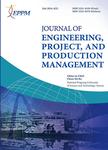版权所有:内蒙古大学图书馆 技术提供:维普资讯• 智图
内蒙古自治区呼和浩特市赛罕区大学西街235号 邮编: 010021

作者机构:Management Studies Department Agnel Institute of Technology and Design Goa Assagao403507 India V M Salgaocar Institute of International Hospitality Education Manora – Raia Goa Salcete 403720 India Department of Information Systems and Operation Management College of Business University of Texas ArlingtonTX76019 United States Department of Information Systems and Computing Technologies College of Business Engineering and Technology Texas A&M University TexarkanaTX75503 United States
出 版 物:《Journal of Engineering, Project, and Production Management》 (J. Eng. Proj. Prod. Manag.)
年 卷 期:2025年第15卷第1期
页 面:1-14页
核心收录:
主 题:Construction industry
摘 要:The safety performance of the construction sector remains subpar despite the utilization of both conventional and new methodologies. Consequently, there is a decline in the standard of work, the efficiency of employees, and an escalation in project expenses and duration. In order to enhance safety, it is imperative for the industry to use cutting-edge digital technologies at every stage of the project’s lifespan. The utilization of these technologies is not yet prevalent and, by far, may be a factor in the poor safety record in the construction industry. This study aims to identify and evaluate factors that impede the use of such technology to improve health and safety in construction management. Literature review and interviews with a few experts were able to garner 18 factors, which were evaluated by experienced industry professionals on a 5-point Likert scale using a questionnaire survey. The responses were analyzed using the relative importance index (RII) and factor analysis. The analyses indicated ‘Employees’ resistance and reluctance to change’, ‘high upfront investment’, ‘lack of awareness about digital technologies and their benefits’, ‘limited trained workforce to work on digital technologies’, and ‘poor data communication infrastructure facilities’ as the top five barriers. Factor analyses churned out six groups: ‘Organization readiness’, ‘Industry readiness’, ‘Country readiness’, ‘Technology related’, ‘Data related’, and ‘Investment related’ on the basis of latent characteristics. The findings will aid firms, the government, and academia in directing resources and planning strategies to improve the usage of C4.0 technologies in safety and health management in the construction industry. Copyright © Journal of Engineering, Project, and Production Management (EPPM-Journal).